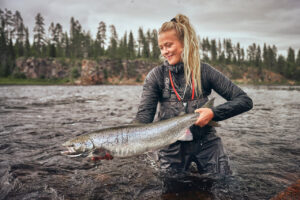Atlantics: The King Clings On

BY V. Paul Reynolds
“Chase the fish, boy..yer down to the backin’..chase the fish,”shouted my guide.
The Medalist reel sang as the 9 weight line wound off the spool with authority. The tip of the Sage fly rod pulsated as the 18-pound Atlantic salmon lived up to its reputation, leaping and twisting above the frothing waters of the Upsalquitch River. The dance of this powerful silver game fish took my breath away. My heart pounded. As instructed, I chased the fighting fish down river stumbling and banging my knees on the slippery stream side stones.
Looking back in my mind’s eye, I can still see those moments vividly. The spirited fish. The long moist fly line arching above the water. And the feeling of the heavy, vibrating fly rod. It was an angling moment like no other.
A few years later, fishing the Penobscot River with the late Tom Hennessey, I had a similarly memorable Atlantic salmon fishing experience, and within eye shot of downtown Bangor. Imagine that?
Will those days ever return?
Good News
It is not beyond the realm of possibility. According to a recent news report, “The last wild Atlantic salmon that return to U.S. rivers have had their most productive year in more than a decade, raising hopes they may be weathering myriad ecological threats. Officials counted more than 1,500 of the salmon in the Penobscot River, which is home to the country’s largest run of Atlantic salmon, Maine state data show. That is the most since 2011 when researchers counted about 2,900 of them. The salmon were once abundant in American rivers, but factors such as overfishing, loss of habitat and pollution reduced their populations to only a handful of rivers in Maine. The fish are protected by the Endangered Species Act, and sometimes only a few hundred of them return from the ocean to the rivers in a year.”
Hope springs eternal. Look closely. Good things are happening.
The most promising salmon recovery story is taking placed on the River Tyne, a once polluted river in Northeast England. There, thanks to an admirable full-press salmon recovery effort, the annual salmon run count is an amazing 12,000 as compared with a meager few hundred in the 1970s!
Maine is now the only remaining U.S. state where the Atlantic salmon’s future hangs in the balance.
The Downeast Salmon Federation is experimenting with the introduction of hatchery-raised salmon parr in the fabled Machias River, with some hopeful outcomes.
Dam Removal
Since dam removals and restoration of the Penobscot’s River’s water quality, the return of, not only the salmon, but other species as well is a stunning demonstration of nature’s incredible capacity to recover from environmental degradation if given a chance.
The Veazie Salmon Club, which was founded in 1978, during the heydays of salmon runs on the Penobscot River, is going strong. Its membership, especially the older, veteran members, remain hopeful that one day their club’s porch bell can be rung again signaling an Atlantic salmon “hookup.”
This winter, ice angler Shawna Stevens jigged a 6-lb Atlantic salmon through the ice at Schoodic Lake near Milo. The 30-inch fished sported a half moon shaped punch through its adipose fin. According to regional fisheries biologist in Enfield, Kevin Dunham, this type of tagging is indicative of an Atlantic salmon that would have been “tagged” from the fishway at the Milford Dam. How did the fish get all the way up the myriad waterways to Schoodic Lake? Says Dunham, “At the right flows and water levels, Atlantics can swim under the gates at the outlet dam. We occasionally get Atlantic salmon in our fall trap nets at Schoodic.”
Fish conservation writer Ted Williams sums it up: “Now, there’s a small glimmer of hope that the king might regain the throne.”
For more articles about hunting, fishing and the great outdoors, be sure to subscribe to the Northwoods Sporting Journal.
